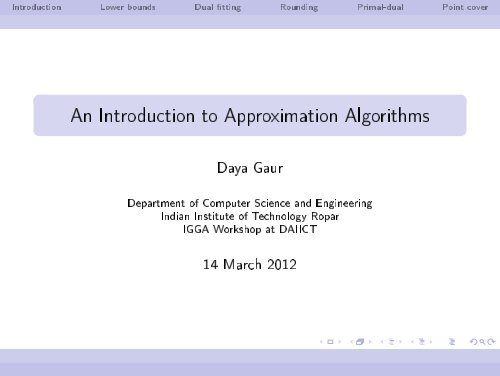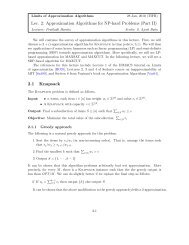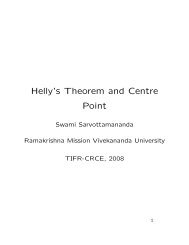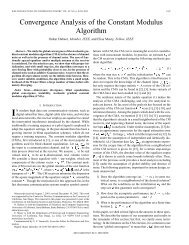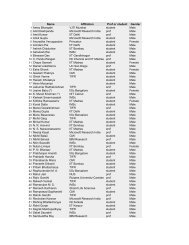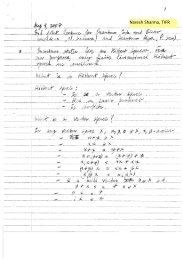An Introduction to Approximation Algorithms - School of Technology ...
An Introduction to Approximation Algorithms - School of Technology ...
An Introduction to Approximation Algorithms - School of Technology ...
You also want an ePaper? Increase the reach of your titles
YUMPU automatically turns print PDFs into web optimized ePapers that Google loves.
<strong>Introduction</strong> Lower bounds Dual tting Rounding Primal-dual Point cover<br />
<strong>An</strong> <strong>Introduction</strong> <strong>to</strong> <strong>Approximation</strong> <strong>Algorithms</strong><br />
Daya Gaur<br />
Department <strong>of</strong> Computer Science and Engineering<br />
Indian Institute <strong>of</strong> <strong>Technology</strong> Ropar<br />
IGGA Workshop at DAIICT<br />
14 March 2012
<strong>Introduction</strong> Lower bounds Dual tting Rounding Primal-dual Point cover<br />
approximation algorithms<br />
Example<br />
trade o accuracy for time.<br />
for every instance we compute an α approximate solution in<br />
polynomial time.<br />
Travelling salesperson: an approximation algorithm returns a <strong>to</strong>ur<br />
no more than twice the length <strong>of</strong> the shortest <strong>to</strong>ur for every<br />
instance.
<strong>Introduction</strong> Lower bounds Dual tting Rounding Primal-dual Point cover<br />
Types <strong>of</strong> approximation algorithms<br />
Good news: there are problems in NP that admit FPTAS.<br />
Bad news: there are problems in NP than do not admit any<br />
approximation algorithm (unless..)<br />
Inapproximability can be thought <strong>of</strong> as more rened study <strong>of</strong> class<br />
NP-C.
<strong>Introduction</strong> Lower bounds Dual tting Rounding Primal-dual Point cover<br />
Vertex cover<br />
IP : minimize ∑ w v x v<br />
v∈V<br />
x u + x v >= 1 ∀(u,v) ∈ E<br />
x v ∈ {0,1} ∀v ∈ V<br />
LP : minimize ∑ w v x v<br />
v∈V<br />
x u + x v >= 1 ∀(u,v) ∈ E<br />
x v ≥ 0 ∀v ∈ V
<strong>Introduction</strong> Lower bounds Dual tting Rounding Primal-dual Point cover<br />
Matching<br />
D − LP : minimize ∑ y uv<br />
(u,v)∈e<br />
∑ y uv ≤ w u for all u ∈ V<br />
v∈n(u)<br />
y uv ≥ 0 ∀v ∈ V<br />
M : minimize ∑ y uv<br />
(u,v)∈e<br />
∑ y uv ≤ w u for all u ∈ V<br />
v∈n(u)<br />
y uv ∈ {0,1} ∀v ∈ V
<strong>Introduction</strong> Lower bounds Dual tting Rounding Primal-dual Point cover<br />
Set cover<br />
IP : minimize ∑ w s x s<br />
s∈S<br />
∑ x s >= 1 ∀v ∈ U<br />
s:v∈s<br />
x s ∈ {0,1} ∀s ∈ S<br />
LP : minimize ∑ w s x s<br />
v∈v<br />
∑ x s >= 1 ∀v ∈ U<br />
s:v∈s<br />
x s ≥ 0 ∀s ∈ S
<strong>Introduction</strong> Lower bounds Dual tting Rounding Primal-dual Point cover<br />
Set cover: dual<br />
LP : maximize ∑ y u<br />
u∈V<br />
∑ y v ≤ w s ∀s ∈ S<br />
v∈s<br />
y v ≥ 0 ∀v ∈ V<br />
ILP : maximize ∑ y u<br />
u∈V<br />
∑ y v ≤ w s ∀s ∈ S<br />
v∈s<br />
y v ∈ {0,1} ∀v ∈ V
<strong>Introduction</strong> Lower bounds Dual tting Rounding Primal-dual Point cover<br />
Shortest paths in digraphs<br />
⎧<br />
⎨<br />
∑ x e =<br />
⎩<br />
e∈n(v)<br />
ip : minimize ∑ w e x e<br />
e∈e<br />
1 if v = s<br />
−1 if v = t<br />
0 otherwise<br />
x e ∈ {0,1} ∀e ∈ E<br />
vertex, edge incidence matrix. (u,e) is 1 is edge goes out from u,<br />
−1 otherwise.<br />
LP relaxation poly<strong>to</strong>pe is integral (integrality gap is 1).
<strong>Introduction</strong> Lower bounds Dual tting Rounding Primal-dual Point cover<br />
Constrained shortest paths<br />
⎧<br />
⎨<br />
∑ x e =<br />
⎩<br />
e∈n(v)<br />
ip : minimize ∑ w e x e<br />
e∈e<br />
1 if v = s<br />
−1 if v = t<br />
0 otherwise<br />
∑ d e x e ≤ d<br />
e∈e<br />
x e ∈ {0,1}∀e ∈ e
<strong>Introduction</strong> Lower bounds Dual tting Rounding Primal-dual Point cover<br />
Constrained shortest paths<br />
IP 1 : min ∑<br />
e∈e<br />
w e x e + λ(∑<br />
∑ x e =<br />
e∈n(v)<br />
⎧<br />
⎨<br />
⎩<br />
e∈e<br />
d e x e − d)<br />
1 if v = s<br />
−1 if v = t<br />
0 otherwise<br />
∑ d e x e ≤ d<br />
e∈e<br />
x e ∈ {0, 1} ∀e ∈ e<br />
Let x∗ be the optimal integral solution <strong>to</strong> the constrainted shortest<br />
path problem. v(ip, x∗) ≥ v(IP 1 , x∗) for λ ≥ 0.
<strong>Introduction</strong> Lower bounds Dual tting Rounding Primal-dual Point cover<br />
Constrained shortest paths<br />
IP L : min ∑<br />
e∈e<br />
∑ x e =<br />
e∈n(v)<br />
w e x e + λ(∑<br />
⎧<br />
⎨<br />
⎩<br />
e∈e<br />
d e x e − d)<br />
1 if v = s<br />
−1 if v = t<br />
0 otherwise<br />
x e ∈ {0,1} ∀e ∈ e<br />
Let x ′ be the optimal integral solution <strong>to</strong> IP L .<br />
v(IP 1 , x∗) ≥ v(IP L , x ′ ) ∀λ ≥ 0.<br />
Theorem<br />
The value <strong>of</strong> optimal solution <strong>to</strong> IP L is a lower bound on the value <strong>of</strong> x∗.
<strong>Introduction</strong> Lower bounds Dual tting Rounding Primal-dual Point cover<br />
Lagrangian relaxation<br />
IP L is the lagrangian relaxation.<br />
we want the best possible lower bound, therefore nd λ such<br />
that optimal <strong>to</strong> IP L maximized.<br />
largarangian can be solved using subgradient methods (note<br />
that the function might not be dierentiable).<br />
or using column generation (dantzig-wolfe decomposition).<br />
lagrangian bound is atleast as good as the linear programming<br />
bound, for integral poly<strong>to</strong>pes the two bounds coincide
<strong>Introduction</strong> Lower bounds Dual tting Rounding Primal-dual Point cover<br />
Greedy algorithm for set cover<br />
r = {}<br />
sol = {}<br />
while r != u<br />
s : min { w(s)/|s \ r| }<br />
sol
<strong>Introduction</strong> Lower bounds Dual tting Rounding Primal-dual Point cover<br />
<strong>An</strong>alysis<br />
Pro<strong>of</strong>.<br />
∑ p(e) = w(sol)<br />
e∈u<br />
consider a set s = (s 1 ,...,s k )<br />
for all<br />
∑<br />
s i<br />
∈s<br />
i, p(s i ) ≤ w(s)<br />
k − i<br />
p(s i ) ≤ w(s)h(k)<br />
p(e)/h(n) is feasible in the dual<br />
by weak duality the performance ratio is h(n).<br />
s ′ is are ordered in the order they are covered by the greedy.
<strong>Introduction</strong> Lower bounds Dual tting Rounding Primal-dual Point cover<br />
Vertex cover<br />
ip : minimize ∑<br />
v∈v<br />
w v x v<br />
x u + x v >= 1 ∀(u, v) ∈ e<br />
x v ∈ {0, 1} ∀v ∈ v<br />
lp : minimize ∑ w v x v<br />
v∈v<br />
x u + x v >= 1 ∀(u, v) ∈ e<br />
x v ≥ 0 ∀v ∈ v<br />
let x ∗ be the optimal lp solution.<br />
x v =<br />
{ 1 if x ∗<br />
v >= 1 2<br />
0 otherwise.
<strong>Introduction</strong> Lower bounds Dual tting Rounding Primal-dual Point cover<br />
Vertex cover<br />
each constraint contains atleast one variable with value ≥ 1/2<br />
in x ∗ .<br />
rounding gives a feasible integral solution.<br />
value <strong>of</strong> the integral solution is at most double the value <strong>of</strong> the<br />
optimal lp solution.
<strong>Introduction</strong> Lower bounds Dual tting Rounding Primal-dual Point cover<br />
Half integrality <strong>of</strong> vertex cover<br />
Denition<br />
A solution <strong>to</strong> an LP is an extreme point if it cannot be expressed as<br />
a convex combination <strong>of</strong> two other feasible solutions.<br />
Lemma<br />
Every extreme point solution is half integral i.e., x v ∈ {0,1/2,1}.<br />
Pro<strong>of</strong>.<br />
a v =<br />
V p = {v | x ∗ v > 1/2} V n = {v | xv ∗ < 1/2}<br />
⎧<br />
⎨ x ∗ ⎧<br />
v + ɛ if v ∈ V p ⎨ x<br />
xv ∗ v ∗ − ɛ<br />
− ɛ if v ∈ V n b<br />
⎩<br />
v = xv ∗ + ɛ<br />
⎩<br />
x ∗ v<br />
otherwise.<br />
x ∗ v<br />
if v ∈ V p<br />
if v ∈ V n<br />
otherwise.
<strong>Introduction</strong> Lower bounds Dual tting Rounding Primal-dual Point cover<br />
Pricing method for vertex cover<br />
Denition<br />
p e ≥ 0 is the price associated with each edge e.<br />
w v is the cost associated with each vertex v.<br />
price p is fair if for every vertex ∑ e on v p e ≤ w v .<br />
Theorem<br />
A fair price is a lower bound on the cost <strong>of</strong> any vertex cover.<br />
∑<br />
∑ p e ≤ w v<br />
e on v<br />
p e ≤ w(s)<br />
∑<br />
v∈s e on v
<strong>Introduction</strong> Lower bounds Dual tting Rounding Primal-dual Point cover<br />
Algorithm<br />
Denition<br />
A vertex is saturated if ∑ e on v p e = w v<br />
an edge is uncovered if neither <strong>of</strong> its endpoints are in the cover.<br />
price <strong>of</strong> e = 0<br />
while there exists an<br />
uncovered edge e<br />
raise price on e<br />
without violating<br />
fairness<br />
s = { v | v is saturated}
<strong>Introduction</strong> Lower bounds Dual tting Rounding Primal-dual Point cover<br />
<strong>An</strong>alysis<br />
Theorem<br />
Cost <strong>of</strong> vertex cover produced is at most twice the fair price.<br />
Pro<strong>of</strong>.<br />
Every vertex in the cover is saturated.<br />
∑<br />
∑ p e = w v<br />
e on v<br />
p e = w(s)<br />
∑<br />
v∈s e on v<br />
2∑<br />
e<br />
p e ≥ w(s)
<strong>Introduction</strong> Lower bounds Dual tting Rounding Primal-dual Point cover<br />
Complementary slackness<br />
n<br />
∑<br />
i=1<br />
P : min<br />
a ji x i ≥ b j ,<br />
∑ n i=1 c ix i<br />
j = 1..m<br />
x i ≥ 0<br />
m<br />
∑<br />
j=1<br />
D : max<br />
a ji y j ≤ c i ,<br />
∑ m j=1 b jy j<br />
i = 1..n<br />
y j ≥ 0
<strong>Introduction</strong> Lower bounds Dual tting Rounding Primal-dual Point cover<br />
Complementary slackness<br />
Theorem<br />
Let x,y be primal and dual feasible solutions. x,y are optimal if<br />
and only if following conditions are satised:<br />
1 x i (∑ m j=1 a jiy j − c i ) = 0 for all 1 ≤ i ≤ n<br />
2 y j (∑ n i=1 a jix i − b j ) = 0 for all 1 ≤ j ≤ m.
<strong>Introduction</strong> Lower bounds Dual tting Rounding Primal-dual Point cover<br />
Relaxed complementary slackness<br />
Denition<br />
Let x,y be primal and dual feasible solutions. x,y are said <strong>to</strong> satisfy<br />
relaxed complementary slackness condition if:<br />
1 x i > 0 =⇒ c i<br />
α ≤ ∑m j=1 a jiy j ≤ c i = 0 for all 1 ≤ i ≤ n<br />
2 y j > 0 =⇒ (b j ≤ ∑ n i=1 a jix i ≤ βb j ) = 0 for all 1 ≤ j ≤ m.
<strong>Introduction</strong> Lower bounds Dual tting Rounding Primal-dual Point cover<br />
rcsc<br />
Theorem<br />
If x,y are feasible and satisfy rcsc then ∑ n i=1 c ix i ≤ αβ ∑ m j=1 b jy j .<br />
Pro<strong>of</strong>.<br />
n<br />
∑<br />
i=1<br />
n<br />
∑<br />
m∑<br />
c i x i ≤ α<br />
i=1(<br />
j=1<br />
m<br />
∑<br />
j=1( n∑<br />
i=1<br />
a ij x i<br />
)<br />
y j ≤ β<br />
a ij y j<br />
)<br />
x i<br />
m<br />
∑ b j y j<br />
j=1
<strong>Introduction</strong> Lower bounds Dual tting Rounding Primal-dual Point cover<br />
Pricing method for vertex cover revisited<br />
α = 1, β = 2<br />
x v > 0 =⇒ ∑ e on v p e = w v<br />
p e > 0 =⇒ x u + x v ≤ 2<br />
primal conditions: pick only saturated vertices in the cover.<br />
dual conditions: from every edge pick atmost two vertices in<br />
the cover.<br />
primal conditions satised by pricing algorithm, dual conditions<br />
satised au<strong>to</strong>matically
<strong>Introduction</strong> Lower bounds Dual tting Rounding Primal-dual Point cover<br />
Point Cover<br />
all the horizontal lines (12) comprise the optimal solution, and the greedy<br />
algorithm will pick all the vertical lines (22). the example can be<br />
generalized.
<strong>Introduction</strong> Lower bounds Dual tting Rounding Primal-dual Point cover<br />
2D<br />
The problem is equivalent <strong>to</strong> vertex cover in bipartite graphs in 2-D.<br />
Theorem ( KönigEgerváry)<br />
The size <strong>of</strong> the minimum vertex cover is the same as the size <strong>of</strong> the<br />
maximum matching in a bipartite graph.<br />
2-D can be solved optimally.
<strong>Introduction</strong> Lower bounds Dual tting Rounding Primal-dual Point cover<br />
d dimensions<br />
Let L be the set <strong>of</strong> all the axis parallel lines, associated with each<br />
line l ∈ L is a binary variable y l whose value is 1 if the line is picked<br />
in the solution, 0 otherwise. L(x i ) is the set <strong>of</strong> axis parallel lines<br />
through point x i .<br />
IP: min ∑ y l (1)<br />
l∈L<br />
∑<br />
l : l∈L(x i )<br />
y l ≥ 1 ∀ x i (2)<br />
y l ∈ {0,1} (3)
<strong>Introduction</strong> Lower bounds Dual tting Rounding Primal-dual Point cover<br />
The linear programming relaxation LP <strong>to</strong> the integer program IP, is<br />
obtained by replacing constraints <strong>of</strong> type (3) with non-negativity<br />
constraints y l ≥ 0. The linear programming dual <strong>of</strong> LP is:<br />
LP-dual: max<br />
n<br />
∑<br />
i=1<br />
z i (4)<br />
∑ z i ≤ 1 ∀ l ∈ L (5)<br />
i : l∈L(x i )<br />
z i ≥ 0 (6)
<strong>Introduction</strong> Lower bounds Dual tting Rounding Primal-dual Point cover<br />
Primal-dual d approximation<br />
while there exists an uncovered point, the algorithm picks all<br />
the d axis parallel lines that go through the point.<br />
set y l = 1 if the line is picked by the algorithm else y l = 0. let<br />
x i be the uncovered point picked in iteration j, then set z i = 1.<br />
solutions constructed above are feasible, and the value <strong>of</strong> the<br />
primal solution is at most d times the value <strong>of</strong> the dual<br />
solution, i.e. the performance ratio is d.
<strong>Introduction</strong> Lower bounds Dual tting Rounding Primal-dual Point cover<br />
R. Bar-Yehuda and S. Even, A linear-time approximation algorithm for the weighted cover<br />
problem. Journal <strong>of</strong> <strong>Algorithms</strong>, 2:198203, 1981.<br />
G. B. Dantzig, L. R. Ford, D. R. Fulkerson, A primal-dual algorithm for linear programs, In Linear<br />
Inequalities and Related Systems, Edi<strong>to</strong>rs Kuhn and Tucker, pages 171181, Prince<strong>to</strong>n University<br />
Press, 1956.<br />
T. Gonzalez, edi<strong>to</strong>r, Handbook <strong>of</strong> <strong>Approximation</strong> <strong>Algorithms</strong> and Meta Heuristics, CRC Press,<br />
2007.<br />
D. Hochbaum, edi<strong>to</strong>r, <strong>Approximation</strong> <strong>Algorithms</strong> for NP-hard problems, PWS Publishing, Bos<strong>to</strong>n,<br />
1997.<br />
V. Vazirani, <strong>Approximation</strong> <strong>Algorithms</strong>, Springer, 2001.<br />
Figures are from Wikipedia.


